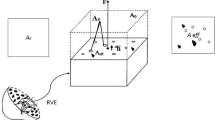Abstract
Ductility takes into account the material capability to plastically deform. This parameter is not only modified by temperature but it is strongly affected by the stress triaxiality that, in the case of positive hydrostatic stress, reduces the material strain to failure. Due to the importance of this parameter in engineering design many attempts to predict the evolution of ductility with stress triaxiality have been done. Here, a nonlinear continuum damage model, as proposed by the author, is used to obtain the evolution of material ductility with stress triaxiality. The expression found relates the strain to failure in multi-axial state of stress regime only to the uniaxial strain to failure, to the damage strain threshold, to the material Poisson's ratio, and, of course, to stress triaxiality. The proposed model was successfully verified comparing the predicted evolution of material ductility with the experimental data relative to several metals. The procedure for the damage parameters identification is also discussed in details.
Similar content being viewed by others
References
Bonora, N. (1997). A nonlinear CDM model for ductile failure. Engineering Fracture Mechanics 58(1–2), 11–28.
Bonora, N., Marchetti, M., Milella, P.P., Maricchiolo, C. and Pini A. (1992). Ductile fracture criteria: An application of local approach based on cavity growth theory in Pressure Vessel Fracture, Fatigue, and Life Management (edited by S. Bhandari, P.P. Milella and W.E. Pennell) Book no. G00668, PVP Vol. 233, ASME New York, 111–115.
Bonora, N., Cavallini, M., Iacovello, F. and Marchetti, M. (1994). Crack initiation in Al-Li alloy using continuum damage mechanics, in Localized Damage III Computer-Aided Assessment and Control. (Edited by M.H. Aliabadi, A. Carpinteri, S. Kalisky and D.J. Cartwright), Computational Mechanics Publication, Southampton Boston, 657–665.
Bonora, N., Gentile, D. and Iacoviello, F. (1996). Triaxiality and ductile rupture in round notch tensile bar (in Italian), Proceedings of XII Italian Group of Fracture National Meeting, Parma, June 1996.
Budiansky, B., Hutchinson, J.W. and Slutsky, S. (1981). In Mechanics of Solids (The Rodney Hill 60th Anniversary Volume). (Edited by H.G. Hopkins and M.J. Sewell). Pergamon Press, Oxford, 13–15.
Chaboche, J.L. (1984). Anisotropic creep damage in the framework of the continuum damage mechanics. Nuclear Engineering and Design 79, 309–319.
Earl, J.C. and Brown, D.K. (1976). Distribution of stress and plastic strain in circumferentially notched tension specimens. Engineering Fracture Mechanics 8, 599–611.
Hancock, J.W. and Meckenzie, A.C. (1976). On the mechanisms of ductile failure in high strength steels subjected to multi-axial stress-states. Journal of the Mechanics and Physics of Solids 24, 147–169.
Lemaitre, J. (1985). A continuous damage mechanics model for ductile fracture. Journal of Engineering Material and Technology 107, 83–89.
Lemaitre, J. and Chaboche, J.M. (1985). Mechanics of Solids Materials, Cambridge Academic Press, (1985).
Lemaitre, J. and Dufally, J. (1987). Damage measurements, Engineering Fracture Mechanics 28(5/6), 643–881.
Le Roy, G., Embury, J.D., Edward, G. and Ashby, M.F. (1981). A model of ductile fracture based on the nucleation and growth of voids. Acta Metallurgica 29, 1509–1522.
Manjoine, M.J. (1982). Creep-rupture behavior of weldments. Welding Research Supplement, 50s–57s.
McClintock, F.A. (1968). A criterion for ductile fracture by the growth of holes. Journal of Applied Mechanics 35, 363–371.
Murakami, S. (1987). Anisotropic aspects of material damage and application of continuum damage mechanics. CISM Courses and Lectures no. 295, (Edited by D. Krajcinovic and J. Lemaitre) Springer-Verlag, Wien-New York, 91–133.
Rice, J.R. and Tracy, D.M. (1969). On ductile-enlargement of voids in triaxial stress fields. Journal of Mechanics and Physics of Solids 17, 210–217.
Simo, J.C. and Ju, J.W. (1987). Stress and strain based continuum damage models I — formulations. International Journal of Solids and Structures 23, 841–869.
Tai, H.W. (1990). Plastic damage and ductile fracture in mild steels. Engineering Fracture Mechanics 36, 853–880.
Thomson, R.D. and Hancock, J.W. (1984). Ductile failure by void nucleation, growth and coalescence. International Journal of Fracture 26, 99–112.
Von Karman, T. (1991). Z. Vereins Deutscher Ing., 55, 1749–1757.
Xia, L.C. and Shih, C.F. (1995). Ductile crack growth-II. Void nucleation and geometry effects in macroscopic fracture behavior. Journal of the Mechanics and Physics of Solids 43, 233–259.
Author information
Authors and Affiliations
Rights and permissions
About this article
Cite this article
Bonora, N. On the Effect of Triaxial State of Stress on Ductility Using Nonlinear CDM Model. International Journal of Fracture 88, 359–371 (1997). https://doi.org/10.1023/A:1007479522972
Issue Date:
DOI: https://doi.org/10.1023/A:1007479522972




